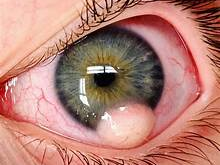limbal dermoid causes hair to grow on the eyeball.
Hair Growing on the Eye? The Shocking Reality of Limbal Dermoid
It sounds like something out of a horror movie, but it’s completely real:
There’s a rare condition called limbal dermoid where hair can actually grow on the surface of the eyeball.

“Ready to be shocked? Start scrolling 👇”
What Is a Limbal Dermoid?
- A limbal dermoid is a type of benign (non-cancerous) tumor made up of normal tissues — just in the wrong place.
- It usually appears at the limbus, the border where the cornea (clear part of the eye) meets the sclera (the white of the eye).
- These growths can contain skin cells, fat, cartilage, sweat glands, and even hair follicles — leading to tiny, creepy hairs sprouting directly from the eye.
How Does It Happen?
- Limbal dermoids are congenital, meaning they form before birth.
- They occur when embryonic tissues meant to develop elsewhere — like skin — mistakenly migrate into the eye area during fetal development.
- The body “thinks” it’s skin, so hair grows as if it’s on an arm or scalp — but horrifyingly, it’s right on the eyeball.
Is It Dangerous?
- Most limbal dermoids are harmless but can affect vision if they grow large or cause the cornea to become irregular (leading to astigmatism or blurred sight).
- In severe cases, surgical removal may be necessary to prevent long-term damage or discomfort.
Shocking Fast Facts:
- Some limbal dermoids grow so large that they look like yellowish or flesh-colored lumps on the eye.
- Hairs growing on the eye surface can irritate the eyelid and cause chronic tearing or infection.
- Ocular dermoid cysts can also form behind the eye, sometimes pushing the eye outward (a condition called proptosis).
Conclusion
While it’s rare, limbal dermoid reminds us just how strange and unpredictable the human body can be.
Hair growing out of an eyeball might sound like science fiction, but for a small number of people, it’s a startling, real-life experience.
Here’s the professional “Solution” section you can post after explaining the Limbal Dermoid fact.
How Is Limbal Dermoid Treated? (Solution)
Although limbal dermoids can sound terrifying, the good news is that they are usually benign and can be treated effectively.
Here’s how doctors typically handle this rare condition:

1. Observation
- If the dermoid is small and not causing vision problems, doctors may recommend simply monitoring it.
- Regular checkups ensure that the growth isn’t enlarging or affecting the eye’s function.
2. Surgical Removal
- If the dermoid causes:
- Blurred vision
- Astigmatism (irregular cornea shape)
- Irritation from the hair
- Or cosmetic concerns
then surgery is the recommended solution.
Procedure Overview:
- An ophthalmologist (eye surgeon) carefully removes the dermoid tissue under local or general anesthesia.
- In some cases, corneal grafts (transplants) are needed if a large portion of the cornea is affected.
3. Post-Surgery Recovery
- Most patients heal well, though some mild scarring or vision correction (like glasses or contact lenses) might be needed afterward.
- Follow-up care is crucial to monitor healing and prevent infection.
Can Limbal Dermoids Grow Back After Surgery?
- Rarely, very small remnants can cause minor regrowth.
- However, with complete removal, the chance of recurrence is very low.
“Enjoyed these facts? We’ve got even more! 👉 Tap here
Important Reminder
👉 If you notice strange lumps, hairs, or vision changes in or around your eye, consult an eye specialist immediately.
Early diagnosis ensures the best possible outcome and protects your vision long-term.
“Which fact surprised you the most? Share with friends or drop a comment below!”
